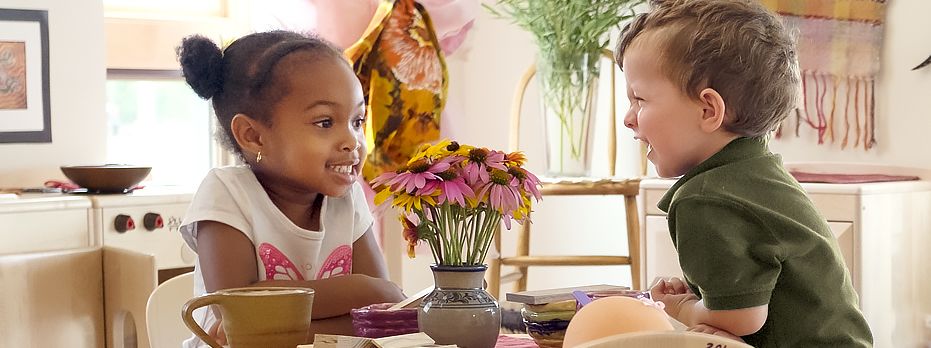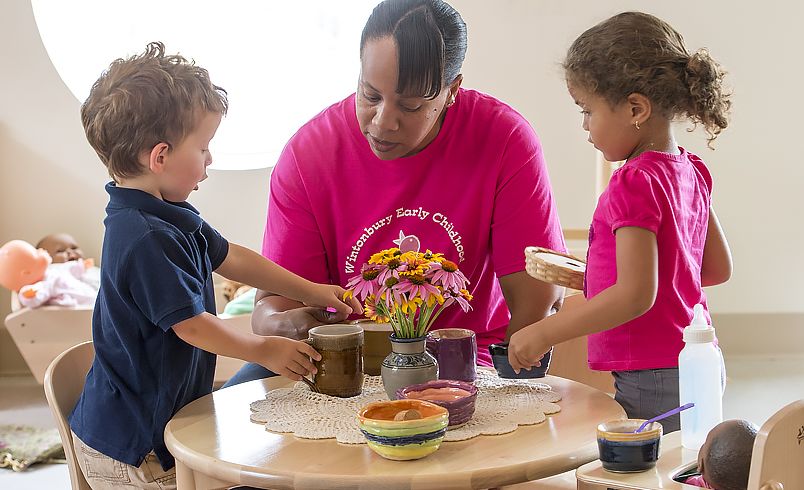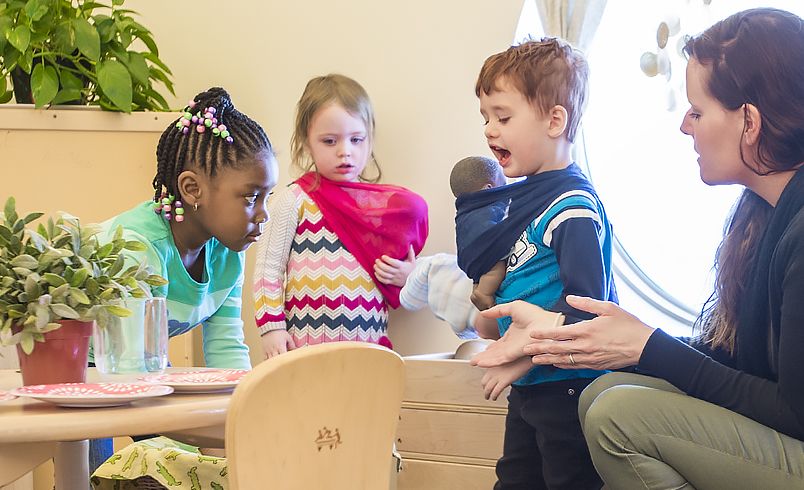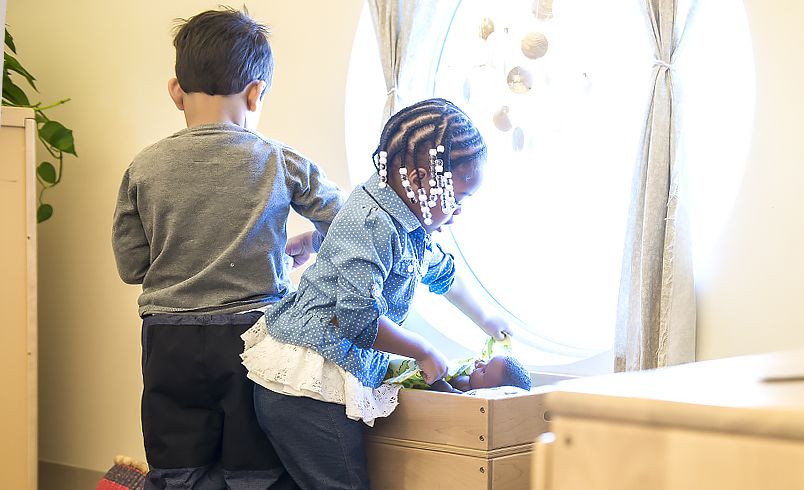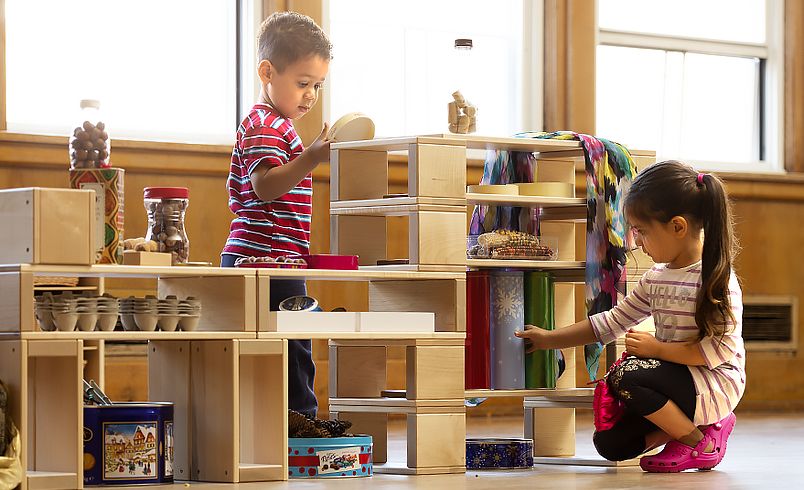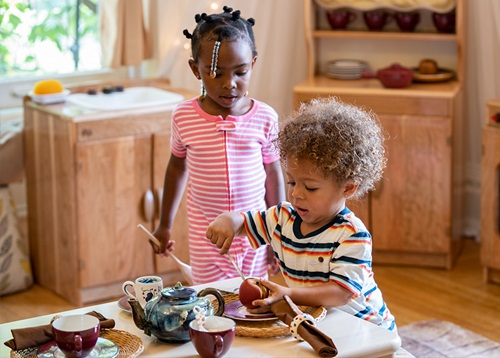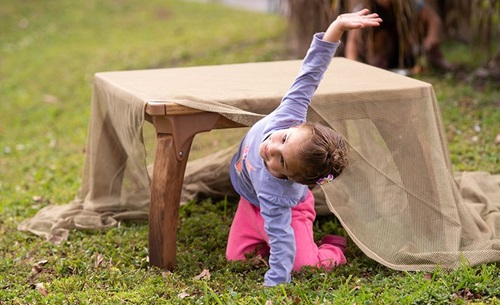More than Dress Ups
Fostering Social and Emotional Development in the Dramatic Play Corner
| September 2018
The dramatic play corner is far more than a “dress up” area. It is a small universe where children inhabit the world of imaginary play giving teachers a window into the child’s inner life. . . . taking what’s private and making it public. It is here that children rehearse important themes in their lives and practice and gain mastery in social skills. Attuned and engaged teachers recognize the importance of their role as a listener, observer, and facilitator so that all children experience the richness of the dramatic play corner.
Unlike so many other areas of the classroom (blocks, manipulatives, art and writing centers, sensory tables, and libraries) where children can choose to play alone, side by side, or together, the dramatic play corner is a group activity. It is here that imaginations soar, storylines become rich in content, and children experience both the messiness and the satisfaction of group play. Peer interactions take place spontaneously and constantly as ideas quickly bounce back and forth among the players. Themes are interwoven and fluid as children bring their own experiences to the group play. With an intentional and sensitive teacher children learn to master hurt feelings, take turns, share ideas, develop self-control, and build resiliency.
Four three-year-old children are busy making cakes for a birthday party. The table is set with plates and cups and the dolls are sitting in chairs ready for the party to begin:
Adam, pretending to stir, says, “This is the chocolate cake.”
Emily says, “You forgot the sugar.” She takes a pitcher and pretends to pour something into the mixture.
Jason quickly joins the group pouring more pretend chocolate, “We need lots more chocolate to taste really good!”
Emily, looking hurt, responds, “In my family we never use so much chocolate, it won’t taste good.”
Adam offers Emily another bowl, “Maybe this cake can be just a little chocolate.”
The children all look pleased with their creation and easily accept each other’s ideas as they pretend to mix both cakes. Initially each child brings his own concept of cake baking to the play. The storyline extends and becomes richer as all of the ideas are blended together.
Abruptly, Noah enters the dramatic play corner. Not stopping to understand the storyline he barges into the group, disrupting the collaborative play the children have established. Grabbing the bowl from Emily’s hands he loudly announces, “I’m a scary monster and I’m making monster stew.”
The dramatic play corner is a natural place for children to practice and master joining ongoing play. An astute teacher will encourage children to stop, look, and listen before entering the play. She’ll help children conceptualize: “What are the children playing? Who are the characters? What can I add to the play so that I’ll be accepted?”
Rather than barging in, grabbing the bowl, and disrupting the play, Noah is helped to join the play gracefully.
“I’m really good at making monster cake, it has lots of ingredients, do you want me to teach you how?” The teacher addresses both Noah’s emotional state and his monster theme while she preserves the established play theme of the group.
The teacher’s role is to scaffold and support play when needed, staying close by but not interfering. Teachers skilled in listening and observing will respond to children’s needs with intentionality. How much frustration and conflict are appropriate for any given group of children? In this instance the teacher might hand Noah some pretend ingredients to keep his play focused, even offering the other children imaginary ingredients to contribute to his monster cake. By doing this the teacher models inclusion and demonstrates positive ways for children to relate to each other. With a different cast of characters who are more adept at working through conflicts, a teacher might watch and listen rather than intervene. Children who are better at self-regulation and who are more resilient are able to tolerate the discomfort and eventual satisfaction of disagreements.
The dramatic play corner requires children to use their language skills to share ideas and create and develop storylines with peers. Play and conversation move at a quick pace, not always staying on the same theme. These themes reflect the inner lives of all the children participating in the play. Although a group of children may be playing together, reenacting a familiar scenario, each brings her own ego-centrism to the play. Through these verbal interchanges children gain flexibility in their thinking as they listen, take turns, negotiate, problem solve, and collaborate with their peers. Because children are usually invested in sustaining play with peers they work hard to find solutions that will work for each of their own needs as well as the group’s needs.
Four girls and two boys, all four years old, are in the dramatic play area taking care of a baby, all with very different ideas of how to put her to sleep.
Sarah, gently holding a baby doll carefully wrapped in a blanket announces, “I’m putting the baby to sleep, everyone needs to be quiet.”
Lily advises, “You need to sing her a lullaby."
Ava asserts, “NO, she needs her book first!”
Sarah, now determined that she is in charge forcefully replies, “I’m the mommy and I get to make the rules.”
Max, just tuning into the commotion excitedly yells, “The monsters are coming, everyone hide, quickly!”
Lily, clearly upset, “Monsters will scare the baby. No monsters allowed.”
Max, asserting himself more loudly, “The monsters are almost here, watch out everyone!”
Lily, questioning, “Can they just be pretend monsters so they won’t scare the baby?”
Max, acquiescing, “OK just this one time they can be friendly pretend monsters.”
Maddy, calmly and quietly brings all of the children to a place where they can collaborate on getting the baby to sleep, “Sshh, you’re all making too much noise. . . . we need to be quiet, or she won’t fall asleep.”
Dramatic play allows children to experience the “what ifs”. What does it feel like to step out of my comfort zone and try on the role of something or someone new and different? For a short time in play a shy, timid child becomes the strong and competent superhero. The aggressive child transforms to the kitten or baby needing to be cared for and nurtured. Not only does the child who transforms gain a new perspective, but with teacher encouragement peers also begin to see children through a different lens, with new strengths and vulnerabilities. A sensitive and responsive teacher can help open the door to peer acceptance of children who are less well received than others in the group.
The dramatic play corner offers a natural setting for children to leave the “here and now” and take on different roles. In our complex world today it is ever more important that children learn perspective taking, thinking beyond themselves and become able to appreciate the feelings of others. Empathy “muscles” are stretched and strengthened as children experience being powerful, nurtured, and nurturing. It is here that children have opportunities to explore and master their own feelings, anxieties, and fears as well as those of their peers.
Recently, at the end of the school year, I observed a group of five-year-old children engaged in a wonderfully rich dramatic play scenario. This group of children exhibited peer acceptance, flexibility, impulse control, frustration tolerance, and perspective taking.
Hollow blocks set the stage for their animal hospital. Clipboards allowed them to “write” everything down that they needed to record. A stethoscope and an assortment of other doctor tools were the props. Everything else was left to their imaginations. The storyline bustled at a quick pace with ambulance sirens, emergency X-rays, bandages needing to be applied and phone calls to bring in more doctors. Animals were suffering and needed immediate attention.
After a few minutes Sophie approaches the scene with a very friendly, “Hi!”
Immediately Eva stops her play and responds, “Sophie, let me tell you what we’re playing. I’m the kitten, they’re the doctors.”
Looking straight at Sophie, Maddy says, “What do you want to be?”
“I want to be the doctor too,” asserts Sophie.
“Meow, meow” cries the kitten ever louder looking for attention from the doctors.
“You can be a doctor too, but I need to tell you which animal has to be taken care of next,” replies Eva looking at the list of patients.
Needing a stethoscope, Sophie reaches to take it out of Maddy’s hand. Before a conflict arises, Maddy, holding her stethoscope tight, says, “There’s another one in there”, pointing to a place in the hollow blocks where the children were keeping supplies.
The teacher later told me that early in the year these particular children had difficulty joining in and sustaining play with peers. Sophie was a child who barged into play without taking the time to notice what her peers were doing. Maddy struggled with being flexible in her play and Eva needed help accepting other children into her storyline.
The children in this class were not “taught” how to interact successfully with their peers. Rather, with the guidance and support of highly skilled and empathic teachers, these children practiced and mastered important social skills through play.
Imaginary play is good for both boys and girls. All children must be allowed and encouraged to spend time recreating their inner worlds. When teachers appreciate the vast amount of learning that takes place in the dramatic play corner, they come to understand and embrace their role in supporting and facilitating group pretend play.

